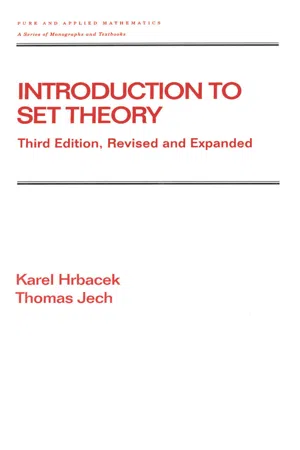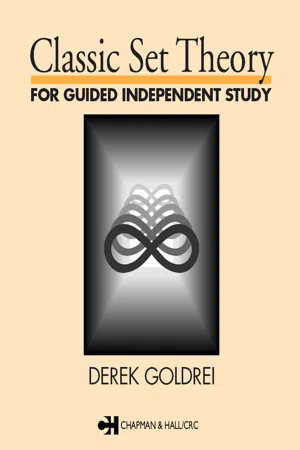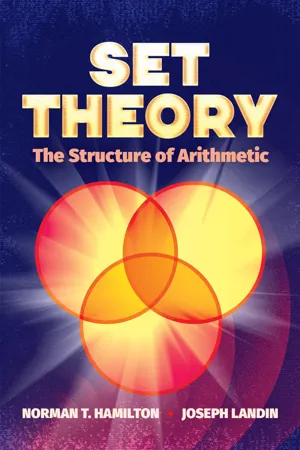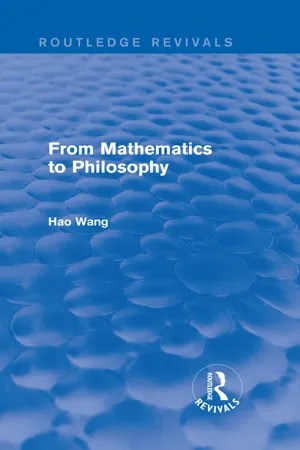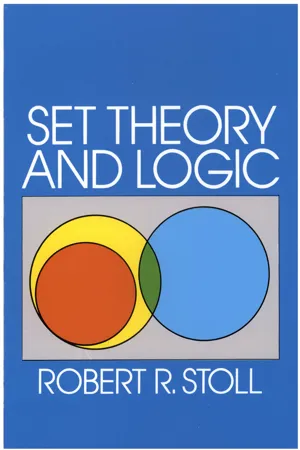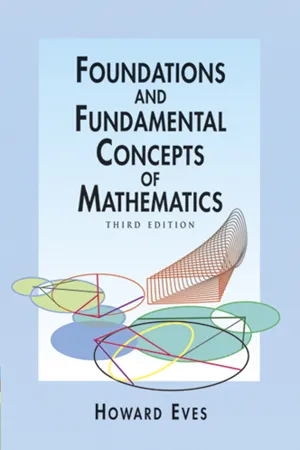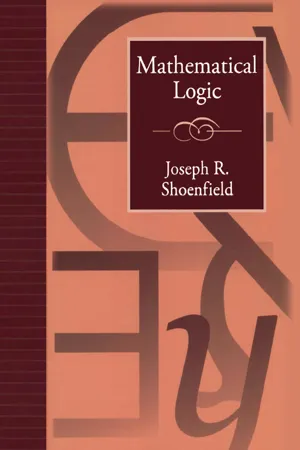Mathematics
Natural Numbers
Natural numbers are the set of positive integers starting from 1 and continuing indefinitely. They are used for counting and ordering objects. In mathematical notation, natural numbers are often represented by the symbol "N" and are fundamental in various mathematical operations and theories.
Written by Perlego with AI-assistance
11 Key excerpts on "Natural Numbers"
- eBook - ePub
- Karel Hrbacek, Thomas Jech(Authors)
- 2017(Publication Date)
- CRC Press(Publisher)
Chapter 3Natural Numbers1 Introduction to Natural Numbers
In order to develop mathematics within the framework of the axiomatic set theory, it is necessary to define Natural Numbers. We all know Natural Numbers intuitively: 0, 1, 2, 3, .. . ,17 , .. . , 324, etc., and we can easily give examples of sets having zero, one, two, or three elements:Ø has 0 elements.{Ø} or, in general, {a} for any a, has one element.{Ø, {Ø}}, or {{{Ø}},{{{Ø}}}}, or, in general, {α,ο} where a ≠ b , has two elements, etc.The purpose of the investigations in this section is to supplement this intuitive understanding by a rigorous definition.To define number 0, we choose a representative of all sets having no elements. But this is easy, since there is only one such set. We define 0 = Ø. Let us proceed to sets having one element (singletons): {Ø}, {{Ø}}, {{θ, {θ}}}; in general, {x}. How should we choose a representative? Since we already defined one particular object, namely 0, a natural choice is {0}. So we define1 ={ 0 }= { θ }Next we consider sets with two elements: {θ, {θ}}, {{θ}, {θ, {θ}}}, {{θ}, {{θ}}}, etc. By now, we have defined 0 and 1, and 0 ≠ 1 . We single out a particular two-element set, the set whose elements are the previously defined numbers 0 and 1:2 =It should begin to be obvious how the process continues:{ 0 , 1 }={ θ ,.{ θ }}3 ={ 0 , 1 , 2 } = { θ , { θ } , { θ , { θ } } }4 ={ 0 , 1 , 2 , 3 } = { θ , { θ } , { θ , { θ } } , { θ , { θ } , { θ } } } }5 ={ 0 , 1 , 2 , 3 , 4 } etc .The idea is simply to define a natural number n as the set of all smaller Natural Numbers: {0,1,..., n — 1}. In this way, n is a particular set of n elements.This idea still has a fundamental deficiency. We have defined 0, 1, 2, 3, 4, and 5 and could easily define 17 and—not so easily—324. But no list of such definitions tells us what a natural number is in general. We need a statement of the form: A set n is a natural number if ... . We cannot just say that a set n - eBook - ePub
- Nita H. Shah, Vishnuprasad D. Thakkar(Authors)
- 2020(Publication Date)
- CRC Press(Publisher)
1 Natural NumbersOur introduction to mathematics starts with positive whole numbers, also known as Natural Numbers. We will be going through informal and formal aspects of all types of numbers. We know that Natural Numbers are not enough for mathematics. For formal aspects of the development and extension of number types, we need background knowledge of some topics in mathematics. Hence, we start with the introduction of these concepts.1.1 Prerequisites
1.1.1 Set Theory
We start with definitions related to sets. First of all, we define set. The definition given here is intuitive and not a formal one. The formal definition may involve some other terms, which may in turn require the definition of those terms. So we start with set as the initial term with an intuitive definition.Definition 1.1: Set is an unordered collection of distinct objects.For a collection being considered to be qualified as a set, one should be able to check unambiguously with certainty whether any object is in the collection or not. Generally, sets have the same type of members, but it is not necessary to be so. It may contain different kinds of objects. A common convention is to represent a set by an uppercase letter, and the member is represented by a lowercase letter. Lowercase letters are used as a member variable symbol, and the actual member can be anything. Using a lowercase letter to represent the member does not mean that members are lowercase letters. To indicate that an object a is in set P , we write, read as a belongs to P or a is in P . Similarly, if b is not in P then we writea ∈ P, read as b does not belong to P or b is not in P .b ∉ POne of the methods to describe a set is listing all its members. If the number of members is large, then … is used to indicate terms similar to listed near it. The method of describing a set using a member list is called roster method. Another method of describing set is by set builder. - eBook - ePub
Classic Set Theory
For Guided Independent Study
- D.C. Goldrei(Author)
- 2017(Publication Date)
- Routledge(Publisher)
3 The Natural Numbers3.1 Introduction
In the previous chapter we saw a way of constructing the real numbers from the rational numbers. The rationals can be constructed from the integers, and these can in turn be constructed from the set of Natural Numbers, ℕ = {0, 1, 2, 3, ...}. In this chapter we shall continue this process of reduction by defining the Natural Numbers in terms of sets.Why sets? One answer to this is that set constructions, in particular ones involving infinite sets, were a vital part of the definition of the reals. Thus set ideas, as well as the Natural Numbers, underlie our work so far. If we can express Natural Numbers in terms of sets, then we have a single foundation for our theory. Using sets in this way will, however, require us to be, or to become, clear about the ways in which we might legitimately use sets. When we were constructing reals in terms of rationals, rationals in terms of integers, etc., we were reasonably relaxed about using familiar properties of the ‘known’ number system when proving statements about the number system being constructed from it. (Strictly speaking, we should perhaps have defined ℕ and proved all of its standard properties, then used these to define ℤ and prove all its standard properties, and then done the same for ℚ and then ∪.) But the use of sets to do much more than take the odd union or intersection is less familiar; and the development of the theory of sets which stemmed from e.g. Dedekind’s and Cantor’s work, turned out to be trickier than anticipated! The impact for this chapter is that we shall have to start the process of formalizing set theory, so that it supports both the special sets which we shall take as the Natural Numbers and will also provide a framework for establishing their familiar properties.Also, as in the previous chapter, there is a different approach to explaining the Natural Numbers, namely by giving axioms for them. Ideally such axioms should be satisfied by essentially just one structure, as is the case with the axioms for a complete ordered field: any two sets satisfying the properties should be isomorphic. Such axioms were devised by Peano and are as follows, expressed in terms of a set X - eBook - ePub
- Norman T. Hamilton, Joseph Landin(Authors)
- 2018(Publication Date)
- Dover Publications(Publisher)
2
THE Natural Numbers
2.1.THE DEFINITION OF THE Natural Numbers
What is a natural number? From early childhood everyone is familiar with the list: “zero,”“one,”“two,” “three,” etc., but what are these words the names of? It is to this question that we propose toFigure 1give an answer. Such words as “four,” “seventeen,” “two hundred eighty-four” are used in English both as adjectives and nouns. Perhaps the adjectival use is the more common. The box in Figure 1 contains five crosses, the circle contains five squares. If challenged to explain what is meant by this statement, one might say that there exists a one-one correspondence between the crosses in the box and the squares in the circle and that use of the same word “five” in both statements conveys this idea. In similar fashion, to say of any set A that A contains five elements can be interpreted to mean that there is a one-one correspondence f between A and B, where B is the set of crosses in the box on this page. This begins to suggest a possible method of defining “five.” We might define the noun “five” to mean a certain set, say the set of crosses in the box in Figure 1 , and then define the adjective “five” by saying that a set has five elements if it can be placed in one-one correspondence with the set, five. In like fashion, we might define “seventeen”; say, seventeen is the set of crosses in Figure 2 .Figure 2Zero is the set of crosses in Figure 3 . The set of crosses in Figure 3 is the empty set; thus, by the proposed definition, zero is ϕ.Figure 3Now there can be some objection to the above procedure. To define five as a certain standard and fixed set seems to be a good idea, but it would be desirable to find a more suitable (and less perishable) set than the set of crosses in Figure 1 - Hao Wang(Author)
- 2016(Publication Date)
- Routledge(Publisher)
II Characterization of General Mathematical Concepts 1 Natural Numbers We successfully learn the use of the Natural Numbers 1, 2, 3, etc. at an early age. It does not seem possible to reduce our knowledge of the sequence of Natural Numbers to anything intuitively more basic. It is hard to imagine how a normal person can fail to use small Natural Numbers correctly. A natural number can be used both as an ordinal and a cardinal number. Thus, take the process of counting We point to one figure and say 1, another and say 2, a third and say 3; then we conclude that there are 3 figures. The square is not 2 but rather the second in our counting. Only the last, 3, is used as a cardinal number. We can count in different orders and yet get the same final result: this seems so obvious that it is hard to imagine how it could be different. It also seems evident that the last ordinal used in counting gives the cardinal number of the collection. We can use different symbols for cardinals and ordinals. We can also, as we often do with Natural Numbers, use the same set of symbols to stand for both ordinals and cardinals. Such a practice is no longer feasible when we come to infinite cardinals and ordinals. Thus, if we view cardinal numbers as obtained by counting, the concept of ordinal number seems more basic. Often we can compare the cardinal numbers of two collections without counting; for example, to determine whether there are enough chairs in a room, for people present, or whether there are more males or females at a dance. In such cases, it is true that the acts of matching off must be carried out one by one in temporal succession, even if it is simply the process of looking to see that each chair is occupied. Nonetheless, the ordinal numbers are not involved because we do not have to keep track of the relative order of which of two chairs was first checked: we need only distinguish checked from non-checked. The concept of more or equal is prior to both cardinals and ordinals- eBook - ePub
Knowledge and the Philosophy of Number
What Numbers Are and How They Are Known
- Keith Hossack(Author)
- 2020(Publication Date)
- Bloomsbury Academic(Publisher)
6 The Natural Numbers Aristotle taught that quantities are the items capable of equality and inequality. Quantities in the same category are equal if they stand in a relation that satisfies the Equality Axioms of section 5.1. The categories of quantity are plurality, continuum and series. Each has its own equality relation: for pluralities, numerical equality; for continua, geometric equality; for series, ordinal equality. Hume tells us that pluralities are numerically equal if ‘the one has always an unite answering to every unite of the other’. Equal quantities are the same size, according to property realism, so numerically equal pluralities are the same numerical size. We can define a natural number as a property that is a numerical size. The Appendix shows that each natural number is the number of itself and its predecessors, from which it follows that infinitely many Natural Numbers exist, and hence that the mereology of pluralities is rich in representatives. This allows us to apply the Homomorphism Theorem to deduce that the Natural Numbers are an infinite system of magnitudes with the algebraic structure of a commutative positive semigroup with a least member. From this follow all the axioms of Peano Arithmetic, except those dealing with multiplication. Section 6.1 introduces Hume’s ‘standard of equality’ and criticizes Frege’s interpretation of it as a ‘criterion of identity’. Section 6.2 gives an alternative interpretation of Hume’s ‘standard’ as the thesis that tallying is an equality. Section 6.3 argues by considerations about decidability and algorithms that tallying is indeed an equality. Section 6.4 says that it is synthetic a priori that tallying is an equality. Section 6.5 says that the axioms of Peano Arithmetic entail the existence of an actual infinity: we are now in a position to prove this. Sections 6.6 and 6.7 say that the number 1 is the smallest natural number, and ‘zero’ can be anything you please that is not a number - eBook - ePub
- Robert R. Stoll(Author)
- 2012(Publication Date)
- Dover Publications(Publisher)
3 The Extension of the Natural Numbers to the Real NumbersIN THIS CHAPTER we carry out another variety of extension of N , +, ·, < , † the system discussed in Sections 2.1 and 2.2 . Three successive extensions are made, the last of which yields the real number system. The first of these may be described as the completion of N with respect to addition–that is, the minimum enlargement of N to insure the solvability of all equations of the type x + n = m with n, m ∈ N . The extended set is the set Z of integers. The second extension amounts to the completion of Z with respect to multiplication–that is, the minimum enlargement of Z to attain the solvability of all equations of the form xb = a with a, b ∈ Z and b≠ 0. The resulting set is the set Q of rational numbers. The third extension amounts to the completion of Q with respect to order–that is, the minimum enlargement of Q , which provides least upper bounds for nonempty subsets of Q which have upper bounds.In addition to those theorems which are of permanent interest, any development of the real number system includes a great number of results having just temporary interest (for example, results which justify various definitions). Each statement of the latter sort is labeled a lemma, and if no proof is in evidence the reader can count on his being asked to supply one in an exercise.Finally, we mention that elementary properties of operations and relations for Natural Numbers are used without explicit reference.1. The System of Natural NumbersOn the basis of definitions and theorems appearing in Sections 2.1 and 2.2 , the natural number sequence N ,´, 0 determines the system of Natural Numbers, N , +, ·, < , by which we mean the set N together with the two binary operations and ordering relation which have been defined in this set. Below is a list of those properties of +, ·, and < and their interrelations upon which this chapter is based. These were all derived as theorems in Sections 2.1 and 2.2 from the assumption that N , ′, 0 is an integral system. Thus, for one who has studied Sections 2.1 and 2.2 , this section (which is preliminary to the developments described in the above summary) is simply an abstract of already demonstrated properties of the system of Natural Numbers. For anyone who, for some other reason, admits the following as valid properties of N , +, ·, < - eBook - ePub
- Juan Jorge Schäffer(Author)
- 2014(Publication Date)
- WSPC(Publisher)
Chapter 9 THE Natural Numbers 91. Principles of counting The natural or counting numbers, 1, 2, 3, etc., are so deeply embedded in our social and intellectual culture that it may seem strange to assert that they require more than cursory analysis. A closer examination of their history and function reveals, however, that the art of counting is the product of a complicated cultural development. Some of the ideas about numbers that seem to us obvious are shown by the historic, anthropological, and linguistic evidence not to have been obvious at all. Among these often imperfectly realized ideas are: the use of a common system of numbers for counting, regardless of the nature of the objects counted; the perception that quantitative judgments about collections of objects are reducible to counting; the notion that numbers can be recorded by symbols that reflect the process of counting. (For some of the evidence on these matters, as well as much more about numbers, an interesting source is K. Menninger, Zahlwort und Ziffer, translated as Number Words and Number Symbols (M.I.T. Press).) The most difficult idea to grasp in all its implications appears to have been the innocent-looking insight that counting goes on and on: there always is a next number. Philosophical discussions about the “potential” or “actual” infiniteness of the set of all numbers have lasted well into the twentieth century of our era. Archimedes (Aρχιμήδης, d. 212 B.C.E.), in his Ѱαμμίτης (The Sand-Reckoner) struggled to make plain a related matter. To simplify his point somewhat: he showed that some huge collection — all the grains of sand in the entire world — was neither “infinite”, as some claimed, nor, as others averred, “not infinite, yet greater than any nameable number”, but was, on the contrary, comfortably within the scope of a well-designed system of counting - eBook - ePub
Number Systems
A Path into Rigorous Mathematics
- Anthony Kay(Author)
- 2021(Publication Date)
- Chapman and Hall/CRC(Publisher)
Chapter 3Natural Numbers, ℕ3.1 Peano's Axioms
People have used the Natural Numbers to count objects for many millennia, and it is perhaps because they seemed to intrinsically exist that it took until the late 19th century for an axiomatic definition of them to appear. The axioms we present below are essentially those published by Giuseppe Peano in 1889, based on ideas in Dedekind's Was sind und was sollen die Zahlen? which appeared the previous year. The five axioms define the set ℕ as follows.Axiom 3.1.1. ℕ has a member, denoted 1.This axiom defines ℕ to be non-empty.Axiom 3.1.2. There is a functionS : ℕ → ℕ, called the Successor Function.The domain and codomain of S are both ℕ, i.e.∀ n ∈ ℕ , ∃ S ( n ) ∈ ℕ. So far, the only member of ℕ that we know of is 1, so we apply the function S to 1 and introduce a symbol,2 : = S ( 1 ). We now have a new member of ℕ, and we can apply S to that and introduce a further symbol,3 : = S ( 2 ). We could proceed further, introducing more symbols for more members of ℕ – but wait! How do we know thatS ( 1 )is not equal to 1 itself, or thatS ( 3 )is not 2, i.e. going back to a previously introduced member of ℕ? The next two axioms ensure that our idea of introducing a new member of ℕ each time we apply the Successor Function is valid.Axiom 3.1.3.The number 1 is not the successor of any natural number; the successor process never brings us back to where we started.1 ≠ S ( n ) ∀ n ∈ ℕ.Axiom 3.1.4. S is an injection.From the definition of “injection”, this means that ifm ≠ n, thenS ( m ) ≠ S ( n )(or, as contrapositive, ifS ( m ) = S ( n ), thenm = n): no two Natural Numbers can have the same successor. This prevents the successor process from going back to a number that has previously been defined as a successor.Axiom 3.1.5 (The Principle of Induction.). SupposeA ⊆ ℕ. If: (a)1 ∈ A, and (b)n ∈ A ⇒ S ( n ) ∈ A, thenA = ℕ.Here A is a set defined by some property, for example, an equation to be satisfied. We may want to prove a theorem that every Natural Number has this property. The axiom states that two conditions are sufficient for this: (a) the number 1 must have the property, and (b) a consequence of a general natural number n having the property is thatS ( n ) - Howard Eves(Author)
- 2012(Publication Date)
- Dover Publications(Publisher)
102We continue the numbering of definitions and theorems that was started in the previous section. Each stage of the program is preceded by a brief paragraph explaining the motivation of the ideas that follow. Without this motivation, some of the definitions might seem highly artificial. It must be understood, however, that the discussion of motivation is quite informal and is not an actual part of the demonstration; in fact, in the discussion some concepts are anticipated even before they are introduced logically. The proofs of the theorems, in large part, are left for the reader to supply. We assume that the familiar properties of the Natural Numbers have been developed and are at our disposal.The Integers
[Motivation Any integer, be it positive, zero, or negative, can be represented as the difference m– n of two Natural Numbers m and n. If m > n, then m–n is a positive integer; if m = n, then m–n is the zero integer; if m < n, then m–n is a negative integer. This suggests the idea of logically introducing the integers as ordered pairs (m, n) of Natural Numbers, where by (m, n) we actually have in mind the difference m–n, although this fact does not enter into any demonstrations. With this interpretation of an ordered pair of Natural Numbers we are led to say that (a, b) = (c, d) if and only if a–b = c–d, or a + d = b + c. Similarly, since (a–b) + (c–d) = (a + c)–(b + d), we are led to define (a, b) + (c, d) to be the ordered pair of Natural Numbers (a + c, b + d), and since (a–b)(c–d) = (ac + bd)–(ad + bc), we are led to define (a, b)(c, d) to be the ordered pair of Natural Numbers (ac + bd, ad + bc).]- eBook - ePub
- Joseph R. Shoenfield(Author)
- 2018(Publication Date)
- A K Peters/CRC Press(Publisher)
CHAPTER 8 THE Natural Numbers 8.1 PEANO ARITHMETICSo far we have studied the general theory of axiom systems. In this and the next chapter, we shall study axiom systems for two fundamental notions of mathematics: natural number and set.The theory N is not a satisfactory axiom system for studying Natural Numbers. It contains only a few of the basic functions and predicates of number theory; and even for these, it contains only some of the evident axioms. In particular, the induction axiom, which is essential in most proofs in number theory, is missing. We shall show that by adding a suitable form of the induction axiom, we obtain a more satisfactory theory.One statement of the induction axiom is that if a set contains 0 and contains the successor of every natural number in the set, then it contains every natural number. We cannot express this form in L(N), since we have no variables which vary through sets of Natural Numbers. Another form of the induction axiom states that if 0 has some property, and if the successor of every natural number having this property also has this property, then every natural number has this property. We cannot fully express this either, since we have no variables which vary through properties of Natural Numbers. However, we can express it for each property of Natural Numbers which can be expressed in L(N).If A is a formula of L(N), then the formulaA x[ 0 ] & ∀ x ( A →A x[ S x ] ) → A(1) is called an induction axiom. The theory obtained from N by omitting N9 and adding all the induction axioms as new nonlogical axioms is called Peano arithmetic, and is designated by P.Our first observation is that many of the usual proofs using induction can be formalized in P. As an example, we prove N9 in P, thus proving that P is an extension of N. Let A be 0=y ∨ 0 < y. Then ⊢Ay [0] by the identity axioms. By N8, ⊢A ↔ 0 < Sy; so ⊢A → Ay [Sy]. Hence ⊢A by the induction axioms. Now let B be x < y → Sx < Sy. Then ⊢Βy
Index pages curate the most relevant extracts from our library of academic textbooks. They’ve been created using an in-house natural language model (NLM), each adding context and meaning to key research topics.
Explore more topic indexes
Explore more topic indexes
1 of 6
Explore more topic indexes
1 of 4
